Email marketing is an integral component of acquisition and retention strategies and has already proven to be an essential tool for ecommerce success. So, if you’re already using email, you’re on the right track. To level-up your email marketing, you need to define and refine how you are using it to communicate with your customers.

We recently conducted consumer research via Meraki Research to help us determine the value of email and how it is accessed and used from mobile and desktop. The results, when used properly, can help businesses decide how to segment communication according to gender, age, and device preferences. It can also answer a multitude of questions for you. For example:
- If you need to direct customers online, will they take action from their mobile phones or only from desktop?
- If your audience is mostly male or female, will they be comfortable accessing your content on mobile or desktop?
- Will your customers find it easy to read your content if they are accessing it via their mobile devices?
Accessing relevant data that supports your customer’s email interactions will help you understand where they struggle, where they’re happy, and most importantly, where to position your content.
Do Customers Find it Easy to Read Emails on Their Phones or Tablets?
In our fast-paced world, many people are accessing content on the move via their mobile phones or tablets. The question is, is it easy to access this content via email or does it cause frustration? In the research conducted, almost half of the respondents (49%) found it easy to read emails on their mobile phones or tablets. 34% of respondents found it easy most of the time. Thirteen percent said it’s sometimes easy, while 2% don’t ever find it easy, and 3% don’t read emails on their mobile devices.
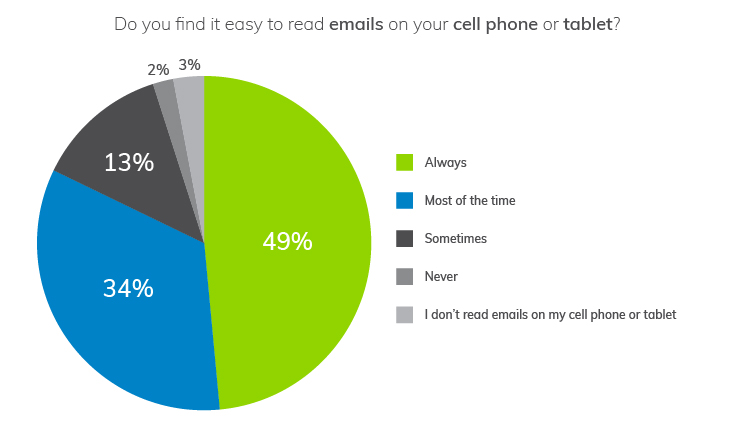
What does this tell us about sending communications via email? The onus is on the business to make email communication easy to digest and navigate, regardless of the device it’s being displayed on. If we look at the second and third groups of people, they find it easy to read email content on their mobile devices most of the time or sometimes. A small percentage don’t find it easy at all, or don’t even try. These customer groups could be converted if it was an easier and more simplified experience.
Customers shouldn’t have to pinch-to-zoom to read email content on mobile devices; it should always be a matter of seamless simplicity from start to finish.
Do Males or Females Find it Easier Read Email Content Via Mobile or Tablets?
Respondents who found it easy to read emails on their mobile phones or tablets were almost evenly split by gender. This was the same regarding all levels of ease when reading email content.
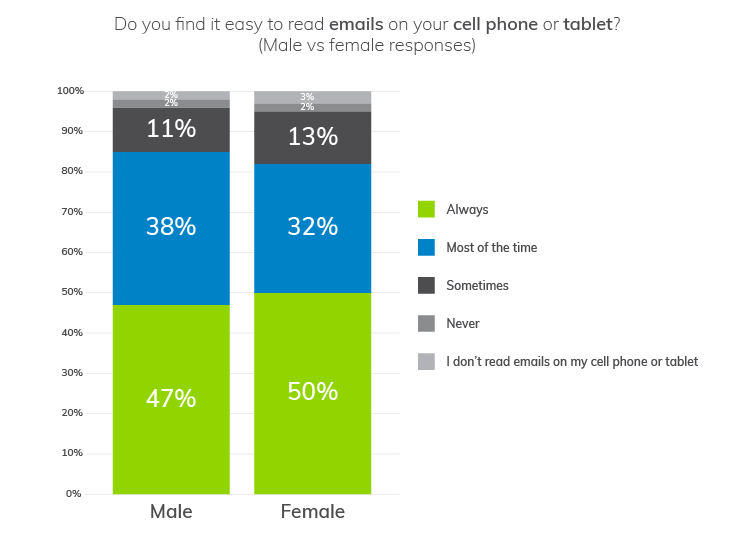
What Age Group Finds it Easiest to Read Emails on Their Phones or Tablets?
Respondents who always found it easy to read emails on their mobile phones or tablets were the 18-to-25-year-old group. As much as 65% of respondents this age have no difficulties in accessing email communication on their mobile devices. Interestingly, the largest percentage of respondents who find it easy most of the time were the 56-to-65-year-old group. While 39% of people over the age of 65 years of age find it easy most of the time.
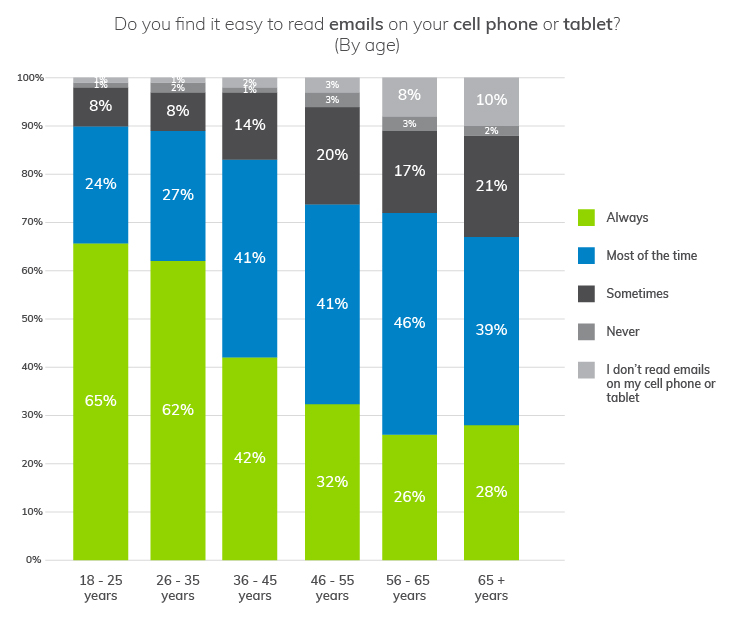
Again, this can tell us how customers of any age are trying to adopt more technologically advanced means of staying in touch. While almost three quarters of the youngest generation of respondents have no difficulties reading email communication on their mobile devices, the older generations should not be ignored. All age groups over 36 years find it easy most of the time, which indicates that they are willing to access content via their mobile phones or devices, provided it’s made simple for them.
Where Do Customers Prefer to Take Action Via Email?
When we speak about taking action via email, it involves clicking links, responding, purchasing products, and engaging in similar actions. This involves a certain level of trust between the customer and the business, but it also comes down to ease of use.
More than a third (41%) of respondents are happy to do everything on mobile, while 28% are comfortable doing it on either mobile or desktop. As much as 23% read content on their phones but will follow up and take action on their desktops, while 8% will do everything on their desktops.
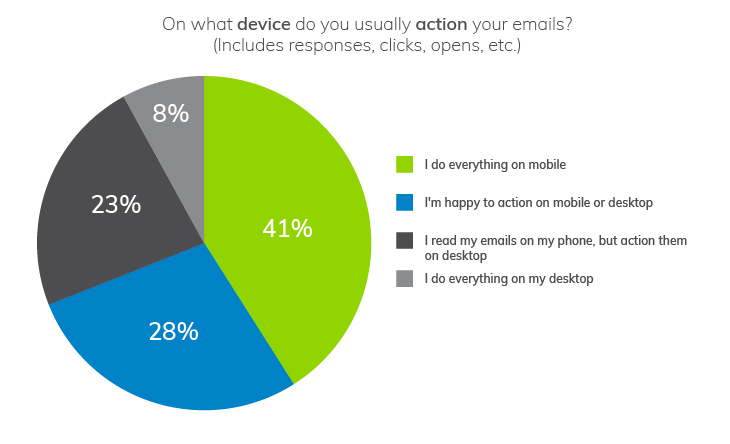
The largest percentage of customers are comfortable taking action on their mobile phones, while almost a third are happy to do so on either mobile or desktop. We will probably see the number of mobile actions and interactions increasing over time as more people find it easier to navigate this process.
Which Gender is More Likely to Action Emails Via Mobile?
The split is almost even when looking at males vs females taking action on email via mobile or desktop. Most are comfortable doing it on their mobile phones or split it between mobile and desktop. Where reading on mobile but actioning on desktop is concerned, perhaps the customer journey is preventing people from feeling comfortable to take action via mobile? It would be useful to dissect this process to gain an understanding as to where barriers lie for your customers.
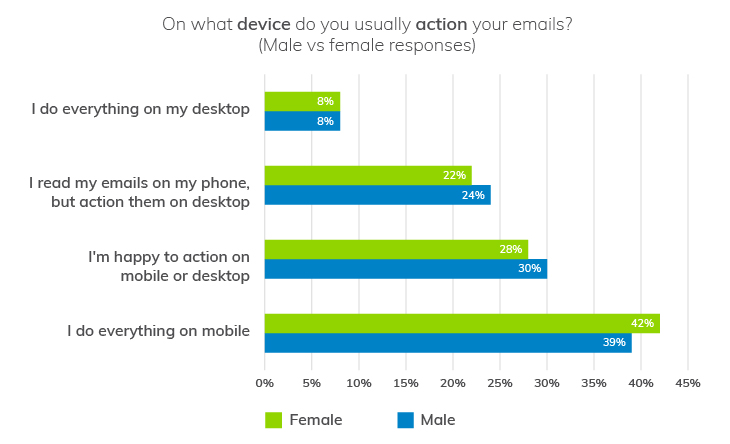
Which Age Group is More Likely to Action Emails Via Mobile?
Over half of the 18-to-25-year-old group is comfortable to take action via email on their mobile phones. This percentage decreases with age, but there are still 19% of over 65-year-olds who are okay with this process.
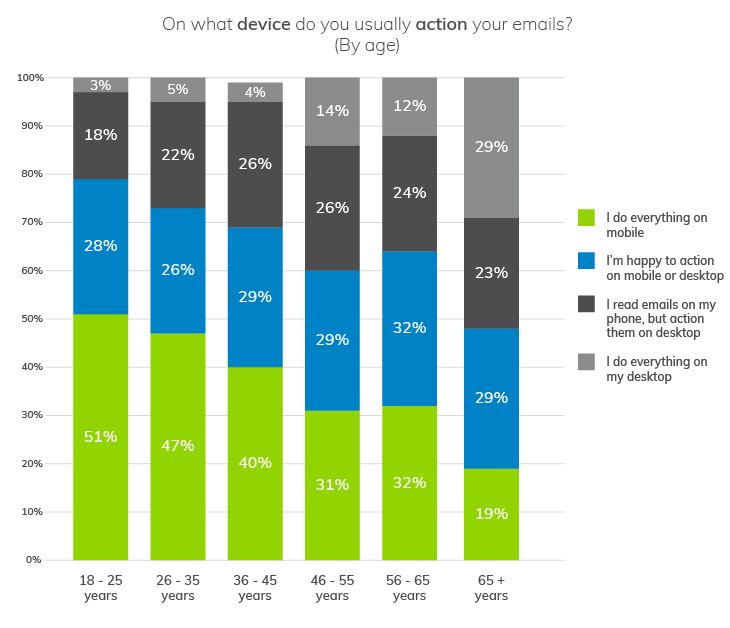
These insights can tell you a lot about customers in general, but it’s worth conducting your own research into your customer base to better understand their specific needs. On the whole, it’s clear that if email communication is easy to read and access from mobile devices, more people would be doing so. When it comes to taking action, we can also assume that customers are more comfortable to do so from mobile if the process is clear and seamless.
Ensuring that your email communications are 100% mobile friendly will make the process of consuming email content and taking action from it as simple as possible, regardless of the device used by your customer. Building trust with your customers is also important so they feel comfortable taking action from your emails. They’ve already given you their email addresses, so what you do with them is up to you. People are willing to adapt provided they don’t have to try too hard. Make it easy. Make it seamless, and you’ll win with your email marketing strategies in no time.












